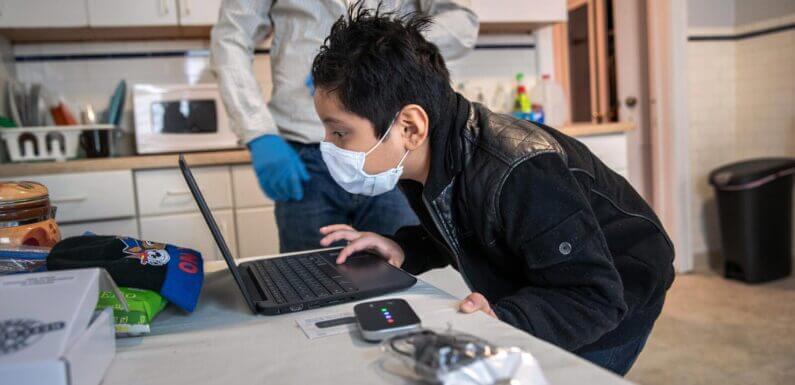
Over the past twenty years, there has been a sharp increase in cases of myopia worldwide. Another observation is that myopia sets in earlier and earlier, especially in youth.
Twenty years ago, this visual disorder appeared mainly in young people aged 12 to 14. Today, optometrists are seeing more and more cases in 8 to 9-year-olds. The World Health Organization associates the progression of myopia with a global epidemic.
How can this phenomenon be explained and can it be stopped? Let’s look into the matter.
What is myopia?
In one of our recent articles, JLR Eye Hospital defined the different vision disorders. Myopia is characterized by clear near vision but blurred distance vision. To give you an idea, being nearsighted is like looking into the distance through a magnifying glass. You will admit that contemplating an outdoor landscape with a magnifying glass is not ideal!
What are the causes?
The hereditary character
The hereditary factor explains the appearance of myopia in young people. Indeed, according to a report, the risk of becoming myopic is multiplied by three, if one of the two parents is affected. This risk is multiplied by seven if both parents are myopic.
However, the observations of the last twenty years are increasingly reporting isolated cases, that is to say of myopic children whose parents are not. The hereditary character is therefore no longer the only factor favoring myopia.
Blue light and our screens
Long hours spent in front of televisions, computers, tablets, and smartphones could largely contribute to the increase in cases of myopia. Especially when we use mobile screens, the blue light emitted by the screens reduces our tendency to force near vision.
Lack of outdoor activities
When indoors, we have to adjust our vision to a multitude of visual stimuli at different distances. Outside, the perspective of things around us is more uniform: our eye does not necessarily have to focus on an object in a close environment.
Spending more time doing outdoor activities contributes significantly to slowing myopic progression, especially in young people 18 years of age or younger.
To reduce the risk of the onset of myopia
- Limit time spent in front of digital screens: For every 20 minutes spent in front of a screen, you should also look 20 feet (6 meters) away for 20 seconds with frequent blinking.
- Adjust the brightness of your screens: software attenuates blue light according to the time of day.
- Increase outdoor activity time to at least 45 minutes per day; it is especially important for children.
- Reading distance is also very important: the distance between your eyes and your book, tablet, or cell phone should be equivalent to the length of a forearm.
- Don’t forget to visit your optometrist for a regular eye exam, especially in the case of reduced vision from afar or visual fatigue.
- Learn about treatments for harmful blue light.
Tips for parents to prevent their children’s myopia
Although myopia is easily corrected, it is important to take this visual disorder seriously since its development of it can have an impact on long-term eye health. Discover 4 tips to take note of if your child is nearsighted.
Tip #1- Schedule your annual eye exam
You may go to any healthcare center, the professionals perform examinations on patients of all ages. Unless there are special cases, we recommend that parents schedule at least an initial eye check-up before starting school, then an exam annually throughout the school career.
If your child has a particular visual condition, for example, a more severe case of myopia (nearsightedness), your optometrist may ask to see him more frequently.
During the period of schooling, good vision is essential since 80% of your child’s learning goes through his vision. By visiting an optometrist once a year, you ensure that your child does not have visual problems that could affect his health, his development, or his academic success.
Note that even if your child has no apparent symptoms, he may have vision problems.
In other cases, your child may show signs of visual problems. For example, if your child regularly squints, tends to look closer when looking at a screen, and complains of discomforts such as blurred vision or headaches, he may suffer from myopia.
Myopia is a condition of increasing concern to eye care professionals since it now appears much earlier in young patients.
Tip #2- Learn about myopia control
Although there is no “cure” for myopia, there are different solutions to control it and slow its development.
With more and more cases observed from the age of 6 or 8, it is important to detect this problem quickly since myopia causes elongation of the eye and weakens the retina.
A case of myopia that appears before the age of 10 and which is not controlled increases the risks of developing a visual handicap in the sixties.
Hence the importance of not only correcting the vision of a child who has been diagnosed with myopia but also learning about the different solutions to curb or slow down the progression of this condition.
Tip #3- Consult the optometrist
Depending on your child’s lifestyle and particular needs, there are different options for controlling myopia. In the clinic, you can take the advice of your optometrist and decide what’s best for your child.
Tip #4- Soft contact lenses
One of the options for controlling myopia is wearing soft contact lenses. The single-use lenses are very popular as they represent a practical and comfortable solution.
They require no maintenance since your child only has to throw away the contact lenses at the end of the day. Since these are daily contact lenses, they are also a flexible solution if your child wishes to alternate between wearing glasses and contact lenses.
In addition to correcting vision, these lenses have been proven to slow the progression of myopia by an average of 59%.
Conclusion
The figures speak for themselves: in the last few years, the number of kids with myopia has increased in many parts of the world, such as the United States and Europe. But in other territories, especially in Asia, the increase is much higher. And we all should go to the best eye hospitals for regular checkups with our kids.
